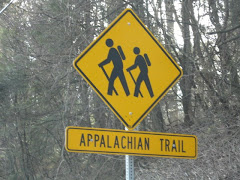Thursday, February 21, 2008
Hogencamp & Pine Swamp Mines
Labels: Hogencamp Mine, New York, Pine Swamp Mine
Friday, February 15, 2008
Ramapo Torne
 L&O and I decided that hiking in blizzard conditions just wasn't enough for us on Sunday, so, we waited for the next storm to roll in on Tuesday and we hiked again (it didn't exactly happen like that, but it makes us sound tougher).
L&O and I decided that hiking in blizzard conditions just wasn't enough for us on Sunday, so, we waited for the next storm to roll in on Tuesday and we hiked again (it didn't exactly happen like that, but it makes us sound tougher).
Our hike begins at the Reeves Meadow Visitor Center (it's closed from Labor Day to Memorial Day, so we didn't get to visit). Take NYS Thruway to exit 15A, turn left at the light onto Route 17 north. Just past the Village of Sloatsburg, turn right onto Seven Lakes Drive, cross over the Thruway. Takes Seven Lakes Drive for about a mile, the Reeves Meadow Visitor Center is on the right.
The red-on-white blazed Pine Meadow Trail begins at the end of the parking lot on the right side. In 0.02 miles, the Pine Meadow Trail makes a sharp right, turn left onto the blue-on-white blazed Seven Hills Trail. The Seven Hills Trail is a walk in the woods for a while, then turns left after about a third of a mile and begins a steep ascent. The trail then levels off near rock formations (don't poke your head into the caves, L&O!), before it begins another ascent. At the top, we pick up the orange-blazed Hillburn-Torne-Sebago (HTS) Trail. We will follow the orange-blazed trail to the Ramapo Torne.
Soon the trail climbs a very steep ascent, this ascent was my downfall (thankfully, not literally). If you choose to hike in nicer weather, this ascent is nothing more than slightly challenging, this was not the case on Tuesday. At the top of the first level (there are two) there is a rock step onto a boulder, this week, the step was solid ice. Somehow L&O scampered up onto the boulder before me. I, after looking down the mountain several times, was not as confident that I could make it. After about 7 minutes of encouraging words from L&O, I managed to pull myself up.
At the top of this first summit, there is level ground and an enclosed rock formation made by several boulders, it seems, from the burnt wood to be a good place for a campfire. The trail then follows another steep ascent, much more manageable.
At the top of the second climb, you reach the Ramapo Torne. We are rewarded with views of Torne Valley, Hillburn and Suffern. Follow the orange-blazed trail as it runs across the ridge and the views change.
You will follow the orange-blazed trail until you reach a junction with the blue-on-white blazed Seven Hills Trail. Continue ahead, now following the joint HTS/Seven Hills Trail blazed with both orange and blue-on-white blazes. After about 0.2 mile, the trails split, bear left and follow the blue-on-white blazes of the Seven Hills Trail (the trail is actually written out on a boulder, hard to miss). The blue-on-white trail descends into a gully. On the day we hiked, this trail was mainly ice which prompted us to slide down (on purpose) our bottoms. I rather enjoyed this part, L&O, not so much. Continue to follow the Seven Hills Trail as it ascends Thorne View. You can view the Ramapo Torne, which we just descended from here.
Just beyond the Torne View, you will reach a junction with the black-on-white blazed Racoon Brook Trail, ignore it and continue on the Seven Hills Trail, which soon begins to descend.
At the base of the descent, the Seven Hills Trail junctions with the white-blazed Reeves Brook Trail. Turn left and follow the white-blazed Reeves Brook Trail. This trail descends the mountain at first steeply, then moderately as it follows the brook. In less than a mile, the trail bears right and begins to follow a woods road. Continue to follow the Reeves Brook Trail until the junction with the red-on-white blazed Pine Meadow Trail, turn left onto the Pine Meadow Trail and follow it a few feet back to the Reeves Meadow Visitor Center parking lot.
Labels: New York, Ramapo Torne




